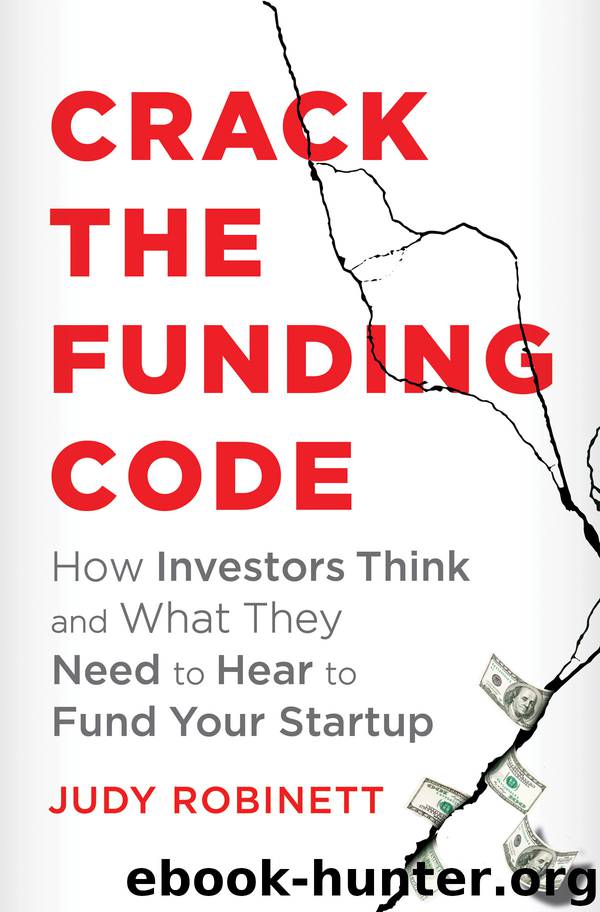Crack the Funding Code by Judy Robinett

Author:Judy Robinett
Language: eng
Format: epub, azw3, mobi
Publisher: AMACOM
Published: 2018-12-19T16:00:00+00:00
Profit and Loss Statement (P&L)
Look at year 1: the P&L shows revenues of $100,000, cost of sales of $90,000, giving a gross profit of $10,000, or a 10 percent gross margin. (Note: If you do a projection that shows a loss for gross profit and a negative gross margin, then something is wrong with your business model and/or spreadsheet model.)
Now look at year 5. Revenues increased from $100,000 in year 1 to $2 million in year 5, a compound annual growth rate (CAGR) of 111 percent. Investors want to see strong revenue growth because that demonstrates the potential viability and market acceptance of your product. Of course, the growth has to be backed up by rational assumptions and reasonable premises that can pass muster under scrutiny.
Over the five years of the projection, gross profit increases from $10,000 in year 1 to $1.4 million in year 5, enabling the gross margin to increase from 10 percent to 70 percent. A business that achieved this kind of growth would be attractive to investors.
Now look at the overhead costs (SG&A), which include things like payroll, benefits, rent, insurance, marketing, technology (internet access, website, and telephony), training, recruiting, and any other costs that do not directly vary with revenues. (Note: You should have backup schedules that detail these costs and tie into this line in your integrated financial projections.)
In the example, overhead costs are $100,000 in year 1 (100 percent of revenues), and they grow by six times to $600,000 in year 5 (30 percent of revenues). These costs are usually a big percentage of revenues in the early years but decline over time as a percentage of revenues, even though the total dollar amount increases. Overhead costs are subtracted from gross profit to derive operating profit, also known by the acronym EBITDA—Earnings Before Interest, Taxes, and Depreciation and Amortization expenses.
Operating profit is a key measure of the profitability of the business and factors into the valuation of the business and its available capital structure. A consistent and growing operating profit enables the company to raise debt, in addition to equity, which can also fund the growth of the company. In our example, there are operating losses in years 1 and 2 even though there is gross profit in those years. But by year 5 operating profit grows to $800,000, or 40 percent of revenues. If the venture achieves these amounts of operating profit, they could consider raising debt in year 6 or 7 (or even earlier) if they need more capital to grow the business at that point.
The expenses below the operating profit line are generally depreciation and amortization, interest expense, and income taxes. Investors like to see these below the operating profit line because they are not controllable in the short run, and because it makes it easy to see EBITDA. It is an important measure of profitability and is used for valuation purposes. In this example, in year 5 the venture achieves EBITDA of $800,000. There are several valuation techniques for
Download
Crack the Funding Code by Judy Robinett.azw3
Crack the Funding Code by Judy Robinett.mobi
This site does not store any files on its server. We only index and link to content provided by other sites. Please contact the content providers to delete copyright contents if any and email us, we'll remove relevant links or contents immediately.
| Private Equity | Valuation |
| Venture Capital |
The Black Swan by Nassim Nicholas Taleb(7010)
Bad Blood by John Carreyrou(6552)
Pioneering Portfolio Management by David F. Swensen(6226)
Millionaire: The Philanderer, Gambler, and Duelist Who Invented Modern Finance by Janet Gleeson(4374)
Skin in the Game by Nassim Nicholas Taleb(4162)
Bullshit Jobs by David Graeber(4094)
The Money Culture by Michael Lewis(4076)
Skin in the Game: Hidden Asymmetries in Daily Life by Nassim Nicholas Taleb(3929)
The Wisdom of Finance by Mihir Desai(3653)
Blockchain Basics by Daniel Drescher(3507)
Liar's Poker by Michael Lewis(3369)
Fooled by Randomness: The Hidden Role of Chance in Life and in the Markets by Nassim Nicholas Taleb(3044)
Hands-On Machine Learning for Algorithmic Trading by Stefan Jansen(3027)
The Intelligent Investor by Benjamin Graham Jason Zweig(2995)
Mastering Bitcoin: Programming the Open Blockchain by Andreas M. Antonopoulos(2981)
The Power of Broke by Daymond John(2897)
Investing For Dummies by Eric Tyson(2894)
Market Wizards by Jack D. Schwager(2643)
Zero Hour by Harry S. Dent Jr. & Andrew Pancholi(2614)
